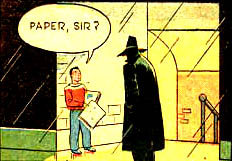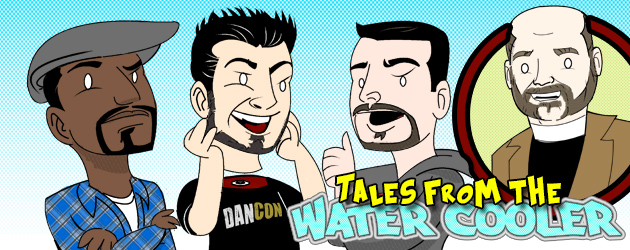Welcome to Retroactive Continuity! In this column, every other Friday I’ll be highlighting odd events in comics history, publication oddities, strange synchronicities, and reviews of older story arcs to round things off. To get the ball rolling, we’ll take a look at a character who’s seen more troubles outside his comics world than he has in his stories.
 In comics history, there’s probably no character who has had a more turbulent history than Fawcett’s Captain Marvel. In his nearly 70 years of existence, he’s gone through more name changes than Prince, had more comebacks than Cher, and been through more legal battles than O.J. Simpson!
In comics history, there’s probably no character who has had a more turbulent history than Fawcett’s Captain Marvel. In his nearly 70 years of existence, he’s gone through more name changes than Prince, had more comebacks than Cher, and been through more legal battles than O.J. Simpson!
Looking at his history, a convoluted picture emerges. Where did he come from? Why did he debut in Whiz Comics #2 (and what happened to #1)? Was he really a blatant ripoff of Superman? Why hasn’t he been as popular in the Modern Age as he was in his Golden Age years?
With the stunning success of Superman in 1938, every publisher wanted their own marquee character to drive sales. In 1939, Fawcett decided to get into the burgeoning comic-book game. Their entry into the genre included a certain red-suited character who would come to be known as Captain Marvel. They hit a few bumps along the way, though. With the explosive growth of the comics industry after Superman’s debut, publishers were scrambling to snap up copyrights, and it was inevitable that conflicts would ensue — and Captain Marvel would be at the center of one of the most famous and longest lasting battles.
Originally conceived as Captain Thunder by creators Bill Parker and C.C.  Beck, Fawcett’s new character would be the flagship character in the company’s Flash Comics. The first issue was drawn and published in late 1939 as a black-and-white ashcan to secure the copyright, but was just beaten out by DC’s Flash Comics. This was only the beginning of the DC/Fawcett saga. A second ashcan was produced, Thrill Comics #1, but once again failed due to the similarity of the name to Standard Comics’ Thrilling Comics.
Beck, Fawcett’s new character would be the flagship character in the company’s Flash Comics. The first issue was drawn and published in late 1939 as a black-and-white ashcan to secure the copyright, but was just beaten out by DC’s Flash Comics. This was only the beginning of the DC/Fawcett saga. A second ashcan was produced, Thrill Comics #1, but once again failed due to the similarity of the name to Standard Comics’ Thrilling Comics.
To add insult to injury, the name Captain Thunder was already used by Fiction House’s Captain Terry Thunder, not to mention DC’s Johnny Thunder, so the powers that be settled on Captain Marvel, shortening the suggestion of “Captain Marvelous” by artist Pete Costanza. Even so, that wouldn’t be the end of the naming controversy, which would crop up again nearly thirty years later.
Captain Marvel finally made his bow in now-titled Whiz Comics #2 in  February, 1940. There was no Whiz Comics #1. It’s generally assumed the two ashcans took the place of #1. The character was an instant hit, and over the next several years, Fawcett took the character to the heights of success. The Marvel Family expanded to include Mary Marvel, Captain Marvel Jr., Uncle Marvel, the Lieutenant Marvels, Mr. Tawky-Tawny, and even Hoppy, the Marvel Bunny. Captain Marvel was also the first super-hero to be featured in a movie, Republic Pictures’ 1941 serial The Adventures of Captain Marvel. By the mid-1940s, Captain Marvel was even outselling Superman with over a million copies per month! The word Shazam! entered popular culture as a “clean” expletive, and even cropped up later as Gomer Pyle’s catchphrase.
February, 1940. There was no Whiz Comics #1. It’s generally assumed the two ashcans took the place of #1. The character was an instant hit, and over the next several years, Fawcett took the character to the heights of success. The Marvel Family expanded to include Mary Marvel, Captain Marvel Jr., Uncle Marvel, the Lieutenant Marvels, Mr. Tawky-Tawny, and even Hoppy, the Marvel Bunny. Captain Marvel was also the first super-hero to be featured in a movie, Republic Pictures’ 1941 serial The Adventures of Captain Marvel. By the mid-1940s, Captain Marvel was even outselling Superman with over a million copies per month! The word Shazam! entered popular culture as a “clean” expletive, and even cropped up later as Gomer Pyle’s catchphrase.
DC Comics was jealously protective of their Superman copyright, though, and in 1941, filed suit against Fawcett alleging Captain Marvel infringed on their Superman copyright. The legal battle carried on for more than a decade, and finally, in 1953, with sales sagging, Fawcett decided to settle out of court and permanently cease publishing the characters. The Big Red Cheese was finally defeated.
Or was he?
The lawsuit accused Fawcett of copying Superman to create Captain Marvel, but is Cap really just a clone of Superman? At first glance, the two are very similar. Both have super-strength, invulnerability, and flight (though Superman developed true flight well after Cap’s debut). Both have mild-mannered alter egos that work in the news industry, and both wear primary-colored costumes featuring tights, boots, and a cape with a distinctive chest logo. There are big differences, though. Superman was an alien whose powers had a scientific basis, but Marvel’s powers were magic-based. While Clark Kent had to look for a phone booth to ditch his street clothes, Billy Batson just had to utter a magic word to transform. Probably most significant, Captain Marvel had a large supporting cast. The Marvel Family predated similar efforts from DC to expand the Superman franchise by adding Superboy, Supergirl, Krypto, etc.
Superman developed true flight well after Cap’s debut). Both have mild-mannered alter egos that work in the news industry, and both wear primary-colored costumes featuring tights, boots, and a cape with a distinctive chest logo. There are big differences, though. Superman was an alien whose powers had a scientific basis, but Marvel’s powers were magic-based. While Clark Kent had to look for a phone booth to ditch his street clothes, Billy Batson just had to utter a magic word to transform. Probably most significant, Captain Marvel had a large supporting cast. The Marvel Family predated similar efforts from DC to expand the Superman franchise by adding Superboy, Supergirl, Krypto, etc.
In truth, Captain Marvel  WAS a copy of Superman, but then again, so were most super-powered characters of the day. The publishers’ orders to the staff was to give them a Superman to call their own. Batman was created under this same imperative (albeit for the same company!). Even today, Captain Marvel is usually portrayed as being on the same level as Superman, power-wise.
WAS a copy of Superman, but then again, so were most super-powered characters of the day. The publishers’ orders to the staff was to give them a Superman to call their own. Batman was created under this same imperative (albeit for the same company!). Even today, Captain Marvel is usually portrayed as being on the same level as Superman, power-wise.
But if Captain Marvel was just another Superman clone, how was he able to outsell the Man of Steel? Part of the reason should be attributed to C.C.Beck’s art. His style meshed perfectly with the characters and Otto Binder’s writing to create a more realistic style than was the norm in the 1940s, less gritty than Superman or other books. Golden Age Captain Marvel stories hold up well even today. Captain Marvel also served as a wish-fulfillment vehicle for the readers of the time. While the reader knew that Clark Kent’s wimpy persona was all an act, and that he was always Superman beneath his coat and tie, Billy Batson was really an ordinary, innocent, poor child who could escape his desperate life with a single word. Despite his situation, Billy always had an optimistic outlook on life. To a poor kid struggling through the Depression and war, Billy was perhaps more identifiable than Clark. Factoring in the entire Marvel Family, Captain Marvel always had allies to call upon (and to support their own stories as well!). Whatever the appeal, by the early 1950s, the entire genre was in decline, and Fawcett decided to cut their losses and pull the plug.
outsell the Man of Steel? Part of the reason should be attributed to C.C.Beck’s art. His style meshed perfectly with the characters and Otto Binder’s writing to create a more realistic style than was the norm in the 1940s, less gritty than Superman or other books. Golden Age Captain Marvel stories hold up well even today. Captain Marvel also served as a wish-fulfillment vehicle for the readers of the time. While the reader knew that Clark Kent’s wimpy persona was all an act, and that he was always Superman beneath his coat and tie, Billy Batson was really an ordinary, innocent, poor child who could escape his desperate life with a single word. Despite his situation, Billy always had an optimistic outlook on life. To a poor kid struggling through the Depression and war, Billy was perhaps more identifiable than Clark. Factoring in the entire Marvel Family, Captain Marvel always had allies to call upon (and to support their own stories as well!). Whatever the appeal, by the early 1950s, the entire genre was in decline, and Fawcett decided to cut their losses and pull the plug.
Next: The DC/Fawcett war is over, but a new competitor enters the arena!
Tom McNeely
tom@comicattack.net



I love the idea behind this column, Tom. Looking forward to more!
Captain Marvel is one of my absolute favorite characters! I wish he would be used more in current continuity. And when I refer to “he” I mean Billy Batson and not Freddy Freeman.
It just seems as if most of it was territorial and DC didn’t want anything remotely resembling their big money maker at the time. Guess it was simpler to just get the property for themselves
I was shazam on Halloween back in the 70’s. In case you were wondering.
‘Speech, that was exactly it! DC had easy pickings since they owned the prototypical character, so they could basically sue anyone they wanted. They had had success against Master Man and the original Wonder Man, so they wanted to take down their biggest competitor! As you’ll see in Part II, DC wins, but there’s another competitor in the mix!
Awesome, great article. I always liked Captain Marvel.
Fantastic article, there was so much there I didn’t know about Captain Marvel. Thank you.
Prince, Cher, O.J. LOL. I love the analogies.
I agree with Jeff Jackson. This is a great idea for an article. And great way to kick it off. I’ll be looking forward to this one every week. Good job!
Awesome article! I wasn’t aware of the legal battles behind the scenes of Captain Marvel. It sounds like DC had a field day suing anybody who sneezed like one of their characters. Can’t wait to hear more. Thanks, Tom!
Pingback: Sequential History: The Birth & Influence of Superman